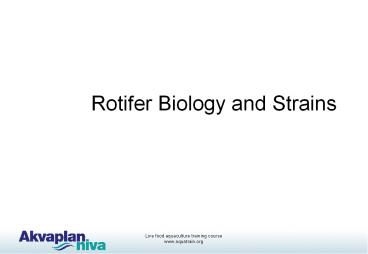Live food aquaculture training course - PowerPoint PPT Presentation
Title:
Live food aquaculture training course
Description:
Rotifer Biology and Strains ... Temperature and reproduction Population dynamics Specific growth rate: u = (lnN2 lnN1)/t Instant production : ... – PowerPoint PPT presentation
Number of Views:110
Avg rating:3.0/5.0
Title: Live food aquaculture training course
1
Rotifer Biology and Strains
2
Systematics
- Phylum Nemahelminthes eller Aschelminthes
- Class Rotifera (lat. Hjulbærer)
- Order Monogononta
- Familiy Branchionidae
- 90 are freshwater species
3
Morphology
- Corona movements and generation of water
currencts for ingestion of feedparticles up to 30
?m - Mastax crushes the ingested particles
- Stomach with glands
- Unpaired gonads
- Primitive excretion system and bladder
- Pseudocoelom function as a hydrostatic skeleton
and cardiovascular system - Common opening for bladder and uterus cloaca
- Foot the pedal has glands tha secreets glue for
fastening to the susbstrate
4
Life cycle I
- Optimal environmental conditions
- Amictic females produce genetic idendical
offspring from diploid eggs - Usually one egg/female is observed
- Suboptimal environmental conditions (mixis
stimulus) - Mictoc female produce mictic (haploid eggs) from
which males hatch - Resting eggs are produced after fertilization of
the mictic egg - Hatching is initiated after stimulus (e.g
temperature/salinity changes)
Resting egg with amictic females
Resting egg
5
Temperature and reproduction
Effect of temperature on the reproduction
activity of Brachionus plicatilis. (After
Ruttner-Kolisko, 1972).
6
Population dynamics
- Specific growth rate u (lnN2 lnN1)/t
- Instant production P ??N
- Relation between growthrate (?) and eggfrequency
(ER) ? ER 0,2 - Expected production the next day P N(ER 0,2)
7
Strain recognition
- SS-type
- S-type lorica shows pointed spines
- L-type lorica shows obtuse angled spines
SS
8
Rotifer strain information
Strain Lorica length (?m) Temperature range Fits for
L-type (Brachionus plicatilis) 130-340 18-25C Larvae until Artemia nauplii is small enough
S-type (Brachionus rotundiformis) 100-210 28-35C Initial feed for larvae with small gapes (sea brea)
SS-type (small strain of S-type) 28-35C Larvae with gapes lt 100 ?m































